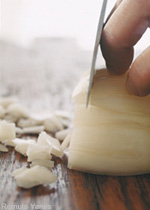
Why spend 45 minutes caramelizing onions when you can get it done in 10… with a little help from a Vidalia and some brown sugar? A reader asked this question and got more of a response than she’d expected: It’s true, you can cook a sweet onion until it starts to soften, add some brown sugar, and end up with a "caramelized" result. And if you’ve only got about 10 minutes, then you might as well do it that way. But you’ll never get the deep flavor that develops with a lower, slower cook.
Onions are full of chemicals, but the two that really make onions, well, onion-y are sulfur compounds and fructose sugar chains. The sulfurs (they morph into all sorts of nastiness when released into the air, including sulfuric acid) are responsible for the tears we all shed while chopping. They evaporate and dissolve when heated, which is why cooked onions don’t make you cry. When cooked over a long period of time (usually 40 to 45 minutes), any remaining sulfurs break down to form new, very sweet- tasting-compounds. Sweeter even than sugar.

Sweet onions are not actually sweeter then their yellow cousins but are grown in areas where soil is low in sulfur (which is why they’re named for the places they grow, like Walla Walla, Washington, and Vidalia, Georgia). And therefore, they contain less of the pungent sulfur compounds, letting the natural sweetness of the fructose sugar chains shine through. Most vegetables store energy in the form of starch. Onions do this as sugar, which, like the sulfurs, breaks down during cooking, bringing a deep caramelized sweetness to the table. This can’t happen in 10 minutes, which is why you’d need to add brown sugar to achieve anything even close to a caramel flavor. The quick method results in a two-dimensional taste: sweet and onion. Long cooking creates a multileveled complexity that can only mean one thing: a patient, careful cook.



 Pinterest
Pinterest


